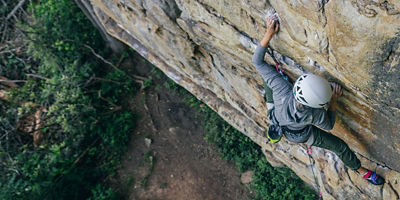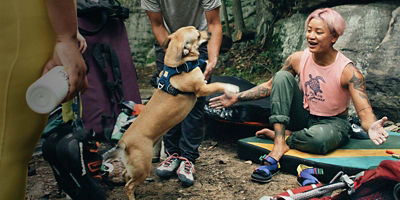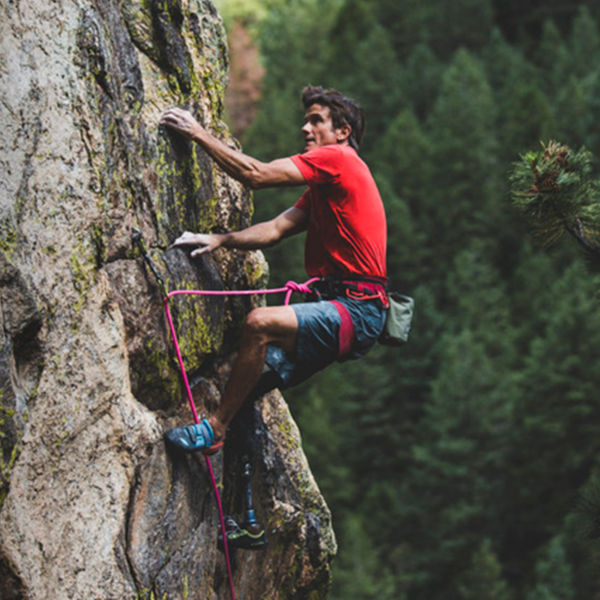
Maybe you’ll be jugging a line to access a big-wall pitch, or getting into position to take some rad photos. But until that day comes, you’re more likely to deal with the other kind of rope climbing: the unplanned, unwelcome, total-emergency ascent. You’ll find yourself staring up 100 feet of nylon and wishing that the line wasn’t wedged in a crack, that your partner hadn’t gotten themselves stuck, or that you weren’t at the moment dangling in space. That’s when it pays to know how to get up a rope—and fast.
Unplanned rope ascents can take a lot of time and effort, but knowing how to pull them off is an essential self-rescue skill. Here are a few scenarios where knowing how to ascend a rope could save the day.
1. You zipped right past your rappel anchor and need to ascend the rope to reach it.
2. Your partner got stuck while rappelling. You need to ascend the rope to assist them.
3. You’ve fallen on a steep climb and can’t quite get back to the rock.
4. Your leader has taken a bad fall, and you’ve successfully escaped the belay. Now you need to ascend the rope to reach them.
5. Your follower has fallen, and you’ve escaped the belay and descended to assist them. Now you need to get back up to your anchor to set up a rappel.
In this guide, we’ll cover a few ways to ascend a rope: without a belay device, with a belay device in guide mode, and with a GriGri assisted-braking belay device.
Necessary Equipment and Skills
The good news: You can ascend a rope with just a handful of things you probably carry on your harness already. Add a few simple knots, and you’ve got all the ingredients you need to learn this essential skill.
Essential Gear
- Tube-style belay device with guide mode (or an assisted-braking device like a GriGri)
- 2 locking carabiners
- 1 Hollow Block loop, Prusik loop, or other material to tie a friction hitch
- 1 double-length (48-inch) sling
Basic Skills
- Use a tube-style device in guide mode
- Tie a Prusik hitch
- Tie an overhand knot
- Optional: Tie a klemheist hitch
- Optional: Tie a clove hitch
How To Ascend a Rope Without a Belay Device
If you fell while following a climb—or you’ve descended a follower’s line using friction hitches because you didn’t have enough line to rappel—you might not be able to add a belay device to the system. In this case, you can use two friction hitches to ascend a rope.
1. Tie a Prusik Loop to the Rope
Use a Hollow Block loop or another small loop of cord to create a Prusik hitch. Clip the hitch to your belay loop with a locking carabiner (remember to lock it).
2. Tie a Safety Knot
If you have enough slack, the easiest backup is a big overhand knot on a bight about four feet below your Prusik hitch (clip it to your belay loop). The sleeker solution: Tie a clove hitch here instead, and fix it to your belay loop with a locking carabiner. That way you can adjust the clove hitch as you ascend the rope, and your rope won’t fill with knots that will have to be untied later.
3. Push the Prusik Upward
When you’ve pushed the Prusik up as high as you can, sit back and let it take your weight.
4. Add a Foot Loop
Now use your double-length sling to tie a klemheist hitch or a second Prusik. This hitch should be between your top Prusik and your backup knot. The sling will act as your foot loop. Pro tip: Clove hitch this loop around your foot to keep it from slipping as you ascend.
5. Stand Up
With your foot in the foot loop, rock your leg under you until you can stand upright, unweighting your waist Prusik. (This can take some practice to do efficiently.)
6. Push Your Top Prusik Upward
With all your weight resting in your foot loop, push your waist Prusik upward again.
7. Rinse and Repeat
Now sit back on your waist Prusik and pull your bottom friction hitch up the rope, high enough that you can repeat steps 6 and 7.
8. Continue Tying Backup Knots
Tie a new overhand knot whenever you’ve accumulated 5 to 10 feet of slack. If you’re using a clove hitch instead, be sure to pull the slack through it as you ascend.























